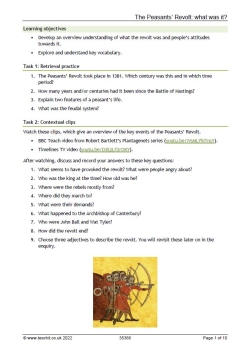The Peasants’ Revolt: what was it?

This introductory lesson is designed to provide an overview of the Peasants’ Revolt, including chronological awareness, some context, and analysis of representations of the Peasants’ Revolt at the time and throughout history.
This lesson is the first part of a four-lesson scheme of work on the Peasants’ Revolt. It includes links to clips, key vocabulary and contemporary sources.
The other lessons in the scheme are:
2. Would the Peasants' Revolt have happened without the Black Death?
An extract from the resource:
|
Key term: revolt (rebellion is very similar) |
|
|
What does it mean generally? When a large amount of people shows their frustration with the people in charge, usually with violence. |
What did it mean at this moment? The rising up of peasants and other ‘ordinary’ people against King Richard II’s government. |
|
Use it in a sentence: Many peasants in Essex and Kent joined the revolt (noun). Many peasants in Essex and Kent decided to revolt (verb). |
What would be the opposite? If people just accepted what was making their lives difficult and carried on. |
